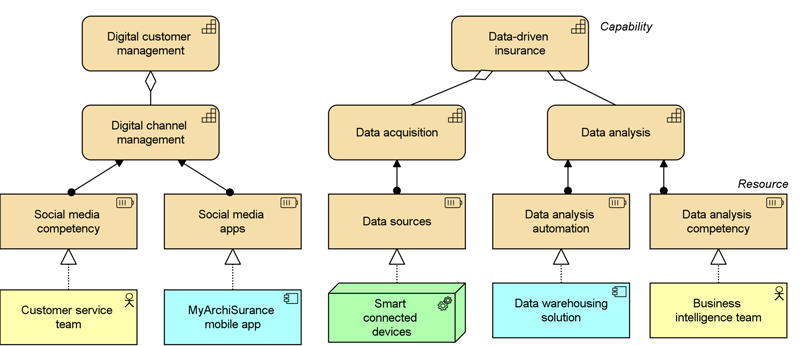As we have seen in the previous blog, ArchiSurance wants to establish several new capabilities to support its ‘Digital Customer Intimacy’ strategy, such as Digital Customer Management, Data-Driven Insurance, Data Acquisition, and Data Analysis. Positioning these in the context of its current capabilities leads to the following figure, using the ‘highlight’ function of Enterprise Studio to emphasize these new elements.

Note that business functions are distinct from capabilities. Capabilities represent the current or desired abilities of an organization, realized by its people, processes, information, and technology. They are focused on specific business outcomes, and are used for strategic planning purposes. In contrast, business functions describe the work actually done by the organization; they are often explicitly managed, and are more closely aligned to the organization structure. Each capability occurs only once in a capability map, whereas in a functional decomposition of the enterprise the same sub-function can occur multiple times.
In describing the baseline business architecture, the value of a capability map mostly lies in the analysis of the current vs. desired levels of capability, and in uncovering capabilities that the organization already possesses but does not recognize or manage explicitly. Capabilities and capability levels in a target business architecture give high-level direction for change. This is the core of capability-based planning.
Of course, when you draw a map of the current capabilities of the organization, its current business functions will often figure prominently, since what you actually do today must by nature be something you are able to do as well. And multiple business functions may (together with other elements) contribute to the realization of a capability.
The figure below shows some of these relationships between a number of primary capabilities of ArchiSurance from the previous figure and its current business functions. The new sub-capabilities from the previous figure are part of the two green capabilities in this figure. These may be realized by augmenting the existing business functions (and the processes within them), but they might also need new functions and resources. For example, the Data-driven insurance capability and its sub-capabilities may require an entirely new part of the organization to be set up, and the Actuarial, Claims and Underwriting business functions may be changed substantially.

These capabilities need to be supported by the right resources including personnel with the right knowledge and skills for the digital age, smart devices for data acquisition, and the customer data itself.

These resources themselves are realized by the enterprise architecture core. A small part of what this may result in is shown as well. Note that this does not depict all elements needed to realize these resources, but only a representative sample. In practice, separate views will often be created to show how individual capabilities and resources are realized.
By putting it all together, this provides a line of sight from your different assets upwards to the capabilities they support and to the strategies, goals and outcomes as outlined in our previous blog. And you can even go further, by connecting more detailed models of, for example, your processes in BPMN or your data in UML, to your architecture model in ArchiMate, just by linking these models together in Enterprise Studio. This way, you can gain insights into the effects of strategic decisions, and vice versa, uncover new options and innovations provided by the resources you employ. Planning, executing and controlling change across your enterprise has never been easier!